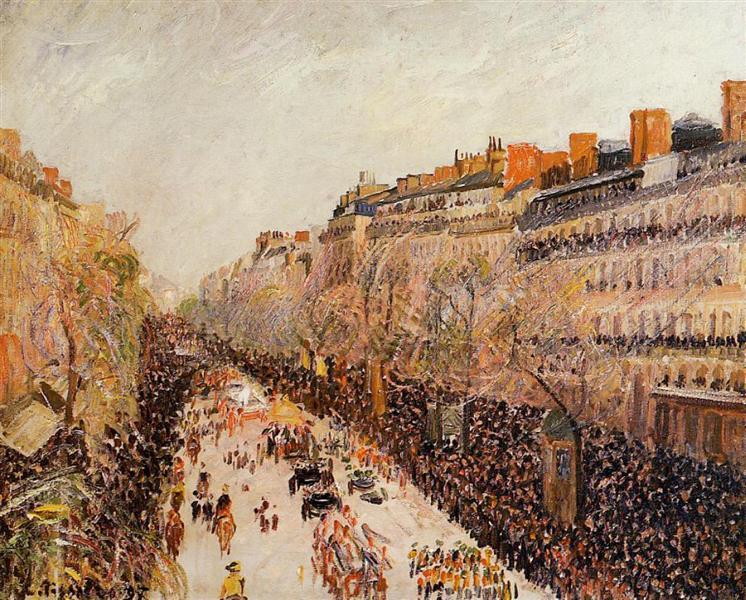Descrição
Camille Pissarro's Mardi Gras on the Boulevards, painted in 1897, is a vivid portrait of urban life in late 19th-century Paris, capturing the energy and bustle of Carnival festivities. As one of the leading exponents of Impressionism, Pissarro uses his signature approach to light and color in this work, creating an atmosphere that seems to pulsate with the joy and dynamism of celebration.
The composition depicts a dynamic scene in which a multitude of figures move along an ornate boulevard, reflecting a sense of communion and collective feasting that is essential to the spirit of Mardi Gras. Pissarro is skillful in depicting people from a variety of perspectives, creating a sense of movement and fluidity. The figures seem to blend into the scene, and although numerous, they do not stand out individually; rather, they become part of a vibrant whole that is the celebration itself. This approach resonates with the Impressionist ideal of depicting life as it flows, often capturing the transience of an experience.
The color in this work is particularly masterful. Pissarro uses a rich and varied palette, highlighting energetic yellows and blues, as well as vibrant splashes of red and green that appear in the costumes and ornaments of the figures. These color choices not only contribute to the joy of the scene, but also illuminate the canvas, creating an almost aura-like effect that provokes an emotional response in the viewer. The loose, textured brushstroke technique, typical of Impressionism, allows the viewer to perceive the movement of light in the surroundings, suggesting how the atmosphere of Carnival is constantly transforming as the day progresses.
The boulevard itself, with its characteristic Parisian architecture, serves as a backdrop for the ebullition of festive life. Pissarro manages to capture not only the crowds, but also the social and cultural context of the moment, reflecting modernity in full effervescence. This connects deeply with the trends of his time, where urban life and social activities were beginning to be celebrated as central themes of painting.
Mardi Gras on the Boulevards also invites us to reflect on the relationship between art and everyday life. Rather than focusing on the majesty of historical figures and events, Pissarro chooses to glorify the ephemeral moment of a public celebration. This work can be seen as a testimony to a period of transformation in society, where urban life began to be perceived not only as a workspace, but as a stage for enjoyment and cultural expression.
Although there may be fewer narrative or allegorical elements compared to earlier works in the classical tradition, Pissarro's signature in this painting lies in his ability to capture the essence of living rather than merely depict what is visible. In short, "Mardi Gras on the Boulevards" establishes itself as a sublime example of the just and pleasurable effect of Impressionism. Thus, Pissarro's work is not only a visual document of a festive occasion, but also a vibrant testimony to an era that was redefining urban and social experience.
KUADROS ©, a famous painting on your wall.
Hand-made oil painting reproductions, with the quality of professional artists and the distinctive seal of KUADROS ©.
Painting reproduction service with satisfaction guarantee. If you are not completely satisfied with the replica of your painting, we will refund 100% of your money.

